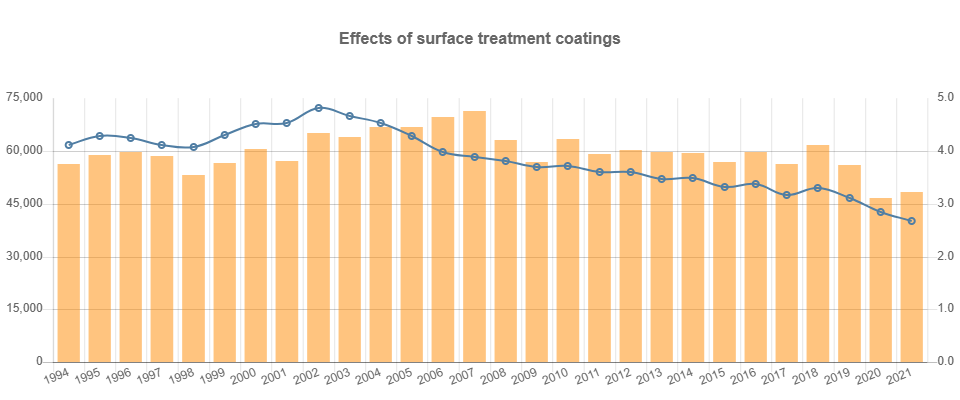Environmental Contribution through Surface Modification Technologies -- Surface Modification Changes the Future --
What is surface modification?
All materials have a surface. Surface modification is a technology that alters only the boundary in contact with the outside world -- in other words, the surface -- without changing the material's inherent characteristics. With this technology, we can develop or significantly alter the original characteristics of a material, occasionally imparting properties that are precisely the opposite of the original ones.
For example, forming a thin film on a steel surface prevents rusting. Meanwhile, steel becomes harder by modifying the depth from the surface to a few micrometers (μm) level, and it prevents wear. In other words, surface modification makes extending the life of materials possible.
Surface modification is derived from the accumulated knowledge of people caring for things. It is a technology that truly embodies the concept of sustainability.
Environmental Contribution through Surface Modification Technologies
What if there were no surface modification technologies?
Undoubtedly, metals will continue to be used as highly beneficial materials. However, much energy is consumed, and GHGs (greenhouse gases) are emitted while obtaining metals from ores. It is important to carefully use metals thus obtained, that is, to protect metals from corrosion as chemical loss and wear and tear as mechanical loss.

Expenses to prevent rust and corrosion (corrosion cost) in Japan are 4.3 trillion yen*1. If the corrosion cost and metal losses (converted from monetary values) are equal and these losses must be recovered, as much as 80 million tons of CO2 will be newly emitted in the metal smelting process. On a global scale, this amounts to as much as 3.8 billion tons of emissions, equivalent to 11% of global CO2 emissions*2. On the other hand, friction and wear costs*3 in developed countries are used to calculate the metal loss in Japan, and if this loss is offset, as much as 80 million tons of CO2, almost equivalent to corrosion, will be emitted in the manufacturing process.
- *1: Japan Society of Corrosion Engineering and Japan Association of Corrosion Control, Cost of Corrosion in Japan (2020)
- *2: Energy Institute, CO2 emissions (EI statistics)
- *3: K. Holmberg:Tribology International, 135, 389-396(2019)
Corrosion cost in Japan
(Cost of rust and corrosion prevention)
¥4.3trillion
Metallic wear in Japan
(Chemical wear + mechanical wear)
160million tons
Nihon Parkerizing Group's Contribution to Reducing CO2 Emissions
We provide automobile manufacturers with chemicals that form surface treatment coatings to prevent automobile bodies from rusting. The surface treatment coatings formed by these chemicals can maintain the original exterior appearance of automobiles for up to three times longer*4. If this reduces the demand to produce new automobile bodies, annual CO2 emissions would be reduced by 1.77 million tons in Japan, where we directly supply chemicals, and by as much as 5.44 million tons globally.
We also provide surface modification technology for hardening surfaces, primarily for automotive parts. This technology can increase the wear resistance by 12 times*5. If we assume a reduced production of automotive parts using this technology, as in the previous example, emissions of CO2 could be cut by 470,000 tons per year in Japan and 2.52 million tons worldwide, including the Group.
We have also been striving to conserve resources and reduce hazardous substances. In particular, since the 1990s, we have been developing products with a reduction of environmental impact as a critical factor in R&D. As a result, we have launched phosphorus-free and chromium-free products and technologies. The figure on the left shows the annual CO2 emissions*6 derived from raw materials related to our domestic chemicals business and annual CO2 emissions converted into values per unit of sales. We have successfully reduced CO2 emissions per unit each year since it peaked in 2002, with a significant 44% reduction achieved to date.
- *4: Calculated based on the results of corrosion acceleration tests (2023) by the Central Research Laboratories, Nihon Parkerizing Co., Ltd.
- *5: Calculated based on the results of an abrasion resistance test (2023) by the Central Research Laboratories, Nihon Parkerizing Co., Ltd.
- *6: Calculated by using IDEA Ver. 3.2 from AIST

Life of car exterior appearance
3 times longer
Surface modification technology for hardening surface increases wear resistance by
12 times
reduction in CO2 emissions:
44 %

